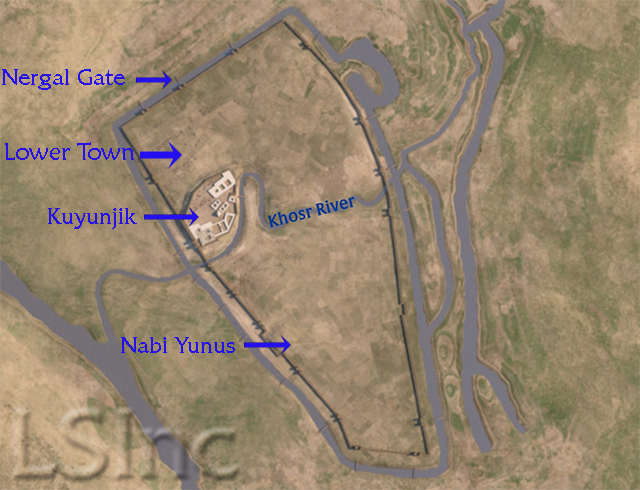 The Lower Town at Nineveh is the area between the citadel mound of Kuyunjik and the northern circuit wall (see aerial view at the left; hover over to enlarge). The University of California, Berkeley, investigated that area in 1989 and 1990 (under the direction of David Stronach and Stephen Lumsden). The work included topographical mapping, a surface survey, investigating deep well-hole trenches, and talking with local farmers about recent land-use patterns.
The Lower Town at Nineveh is the area between the citadel mound of Kuyunjik and the northern circuit wall (see aerial view at the left; hover over to enlarge). The University of California, Berkeley, investigated that area in 1989 and 1990 (under the direction of David Stronach and Stephen Lumsden). The work included topographical mapping, a surface survey, investigating deep well-hole trenches, and talking with local farmers about recent land-use patterns.
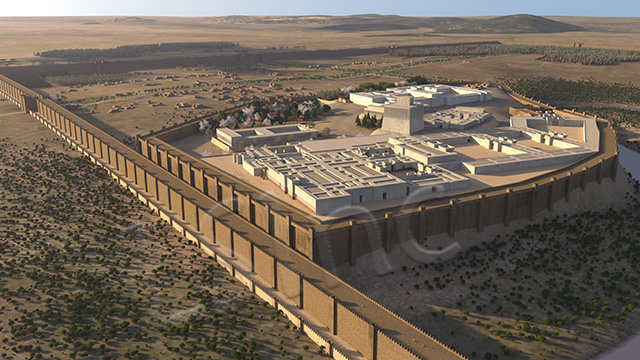 The surface survey revealed a predominance of Neo-Assyria debris over nearly the entire area north of the citadel and evidence of the elaborate and well-paved roadway system laid out by Sennacherib. Evidence was also found for an industrial quarter along the northern wall, scattered garden areas, and large houses (like the one described here below; see the overview of the city, looking north, at the left, with house MG22 just visible at the top left just inside the Mashki Gate; hover over to enlarge).
The surface survey revealed a predominance of Neo-Assyria debris over nearly the entire area north of the citadel and evidence of the elaborate and well-paved roadway system laid out by Sennacherib. Evidence was also found for an industrial quarter along the northern wall, scattered garden areas, and large houses (like the one described here below; see the overview of the city, looking north, at the left, with house MG22 just visible at the top left just inside the Mashki Gate; hover over to enlarge).
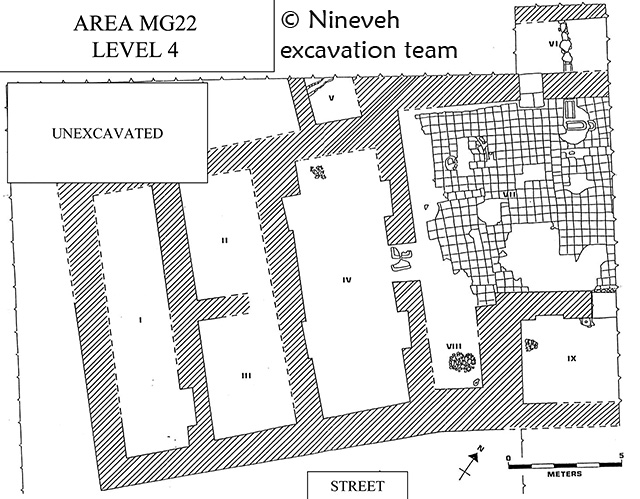 Excavations just inside the city from the Mashki Gate (or the Gate of the Watering Places or the Water Gate, according to Sennacherib's texts) uncovered a partially surviving mansion, designated MG22 by the fieldteam. The house measures roughly 17m x 24m as preserved, but was certainly much larger (based for example, on similar houses from Assur, such as the Grosses Wohnhaus and the Rotes Haus; see the plan at the left, courtesy of Stephen Lumsden; hover over to enlarge). The existing plan of MG22 consists of a large tile-paved inner courtyard with rooms surrounding it on three sides. The best preserved suite of rooms are at the southwest and consist of a reception room with wide shallow niches in the walls, with smaller more private rooms behind. The niches sometimes contained Mosul marble floor slabs and may have been for libations or for letting light and air into the room. There is no evidence for a second story.
Excavations just inside the city from the Mashki Gate (or the Gate of the Watering Places or the Water Gate, according to Sennacherib's texts) uncovered a partially surviving mansion, designated MG22 by the fieldteam. The house measures roughly 17m x 24m as preserved, but was certainly much larger (based for example, on similar houses from Assur, such as the Grosses Wohnhaus and the Rotes Haus; see the plan at the left, courtesy of Stephen Lumsden; hover over to enlarge). The existing plan of MG22 consists of a large tile-paved inner courtyard with rooms surrounding it on three sides. The best preserved suite of rooms are at the southwest and consist of a reception room with wide shallow niches in the walls, with smaller more private rooms behind. The niches sometimes contained Mosul marble floor slabs and may have been for libations or for letting light and air into the room. There is no evidence for a second story.
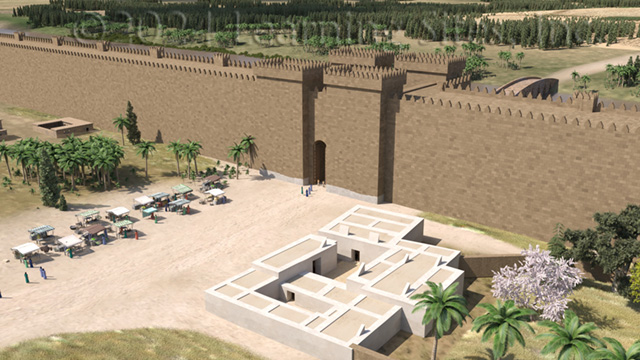 Mansion MG22 was most likely home and offices for the administrator of the Mashki Gate, collecting taxes, inspecting shipments, and other related duties. Excavation data and helpful interpretations and suggestions have been graciously provided to Learning Sites by Stephen Lumsden, one of the excavators (see our reconstruction of the house and vicinity at the left; hover over to enlarge).
Mansion MG22 was most likely home and offices for the administrator of the Mashki Gate, collecting taxes, inspecting shipments, and other related duties. Excavation data and helpful interpretations and suggestions have been graciously provided to Learning Sites by Stephen Lumsden, one of the excavators (see our reconstruction of the house and vicinity at the left; hover over to enlarge).
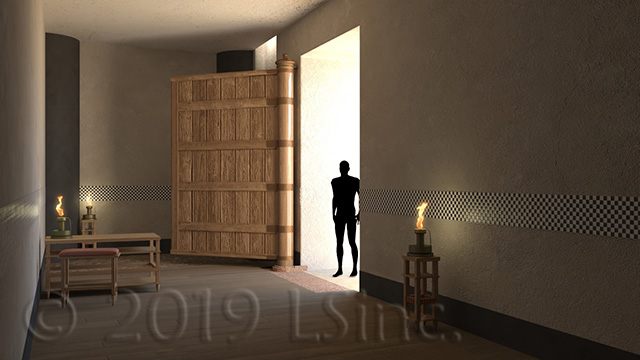 At the left (hover over the image to enlarge) is a view into Room IX (see the plan above), one of the administrative rooms of the building, probably where visitors went to complete their transactions. Excavations found traces of a low black bitumen dado, bits of black and white checkerboard-patterned plaster on the floor, and indications of a pivot stone for the massive door.
At the left (hover over the image to enlarge) is a view into Room IX (see the plan above), one of the administrative rooms of the building, probably where visitors went to complete their transactions. Excavations found traces of a low black bitumen dado, bits of black and white checkerboard-patterned plaster on the floor, and indications of a pivot stone for the massive door.
Lumsden, Stephen
2006 "The Nineveh Lower Town Project," an unpublished paper presented in Edinburgh, Scotland, at the annual meeting of the British Association of Near Eastern Archaeologists, January, 2006.
Stronach, David & Stephen Lumsden
1992 "UC Berkeley's Excavation at Nineveh," The Biblical Archaeologist 55.4:227-33.